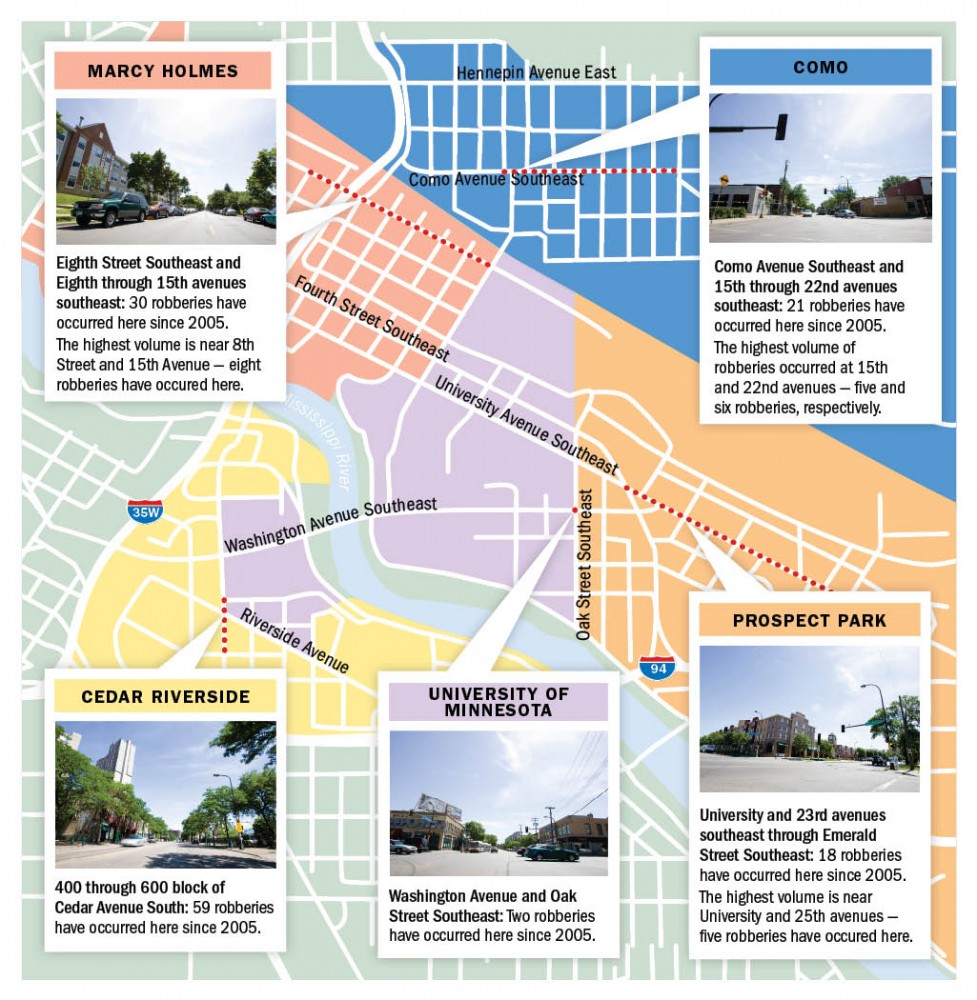Watching the cars pass beneath her on Interstate 35W, Sarah Van Nevel strolled across the stained concrete of the rusty Fifth Avenue walking bridge on her way home from campus like usual the night of May 30. She didnâÄôt worry about walking alone âÄî she had never been robbed before. But as Van Nevel began her descent toward the bridgeâÄôs curved exit, two men approached her from the dark landing beneath the bridge. Both held handguns, Van Nevel said. âÄúGive us all of your cash,âÄù one of the men demanded. She froze. âÄúI donâÄôt have any money,âÄù the 22-year-old journalism senior remembers telling them. She opened her purse to prove it. âÄúThis is all I have,âÄù she said, showing them the credit cards and cell phone in her bag. Van Nevel was lucky. She didnâÄôt get hurt, and didnâÄôt lose anything during her encounter âÄî the men fled when she started screaming. âÄúI think I definitely seemed like a good target,âÄù Van Nevel said, recalling the incident. âÄúI was walking alone, not necessarily paying attention.âÄù Van Nevel is one of the 525 robbery victims in neighborhoods surrounding the University of Minnesota since the beginning of 2005, according to statistics maintained by Minneapolis and University police. However, incidents of violent crime such as robbery and aggravated assault have actually decreased across around the University campus and Minneapolis in recent years, following a national trend. There was a 2.5 percent decrease in violent crime nationwide in 2008, according to FBI statistics. A 3.8 percent drop in violent crime occurred in the Midwest alone. Among one of the sharpest drops in violent crime came from the Cedar-Riverside neighborhood, which since 2006 has seen robberies decrease 63 percent, falling from 89 incidents to 30 in 2008. Cedar-Riverside accounts for almost 44 percent of all robberies around the University since 2005, a number some business owners claim cannot be fairly compared to other neighborhoodsâÄô crime rates, given the areaâÄôs unique cultural position. âÄúYouâÄôve got 5,500 poor people, most of whom donâÄôt speak English, living in a size less than ten acres,âÄù Todd Smith, owner of the Nomad World Pub , located on Cedar Avenue South, said, referring to the dense Somali population on the West Bank. âÄúTo compare our neighborhood to Marcy-Holmes and say âÄòHey, weâÄôve got more crimeâÄô without looking at the larger societal context of whatâÄôs going on in our neighborhood would be doing our neighborhood a disservice,âÄù Smith said. The Cedar-Riverside neighborhood has been synonymous with cultural diversity for years. Some have also associated it with crime; 76 percent of robberies around campus neighborhoods in the last five years occurred in the Cedar-Riverside and Marcy-Holmes neighborhoods. The 400 through 600 blocks of Cedar Avenue South have produced the largest amounts of robberies in that period. In four-and-a-half years, there have been 59 robberies on the three blocks, the majority of them occurring at night. Funding cuts from state budgets are causing Minneapolis police to focus their efforts on downtown Minneapolis, which shares the 1st Precinct with Cedar-Riverside, Smith said. Because of this, he said, the police presence is insufficient. Minneapolis police Sgt. Jesse Garcia disagreed . âÄúWe have a squad assigned to patrol Cedar-Riverside at all times,âÄù Garcia said. University police make their presence known in Cedar-Riverside as well, due to patrols around the UniversityâÄôs West Bank campus, Univerisity police Deputy Chief Chuck Miner said. The Cedar-Riverside area is littered with bars, ethnic restaurants and shops, and business owners are being proactive by taking measures to improve the neighborhood. West Bank Business Association board member Jennifer Blevis , also director of the Bryan Coyle Community Center , is active with several organizations intent on improving the neighborhood. Blevis and Smith are contributing parts of the West Bank Community Coalition , which works with the WBBA and the Cedar Riverside Neighborhood Revitalization Program to provide services such as safety patrols and youth programs to spark community involvement. The coalition also raised money and installed a surveillance system on Cedar Avenue streets that police can monitor from a remote location. The cramped living conditions of poor Somalis remains a challenge for police and business owners, Smith said. âÄúThe biggest challenge is not crime, itâÄôs the immense poverty,âÄù Smith said. âÄúUntil somebody wants to have an open story about what Riverside Plaza is, and how that type of housing policy is ineffective, the neighborhood will continue to have challenges.âÄù
Other neighborhoods
In contrast, the Como neighborhood has seen small amounts of robberies within the last five years, averaging little more than 10 robberies per year âÄî discordant from Cedar-Riverside, which averages more than 50 robberies per year. Programs intended to help inform residents of robbery prevention strategies have helped reduce robberies, but canâÄôt solve all problems, Southeast Como Improvement Association Neighborhood Coordinator James De Sota said. âÄúMarcy-Holmes, Prospect Park and Cedar-Riverside are all doing as much as us, if not more,âÄù De Sota said. âÄúPart of it is location, part is access. There are only a few major thoroughfares leading into the Como neighborhood.âÄù The Marcy-Holmes neighborhood dealt with 181 of the 525 robberies reported around campus since 2005, according to police statistics. The Marcy-Holmes Neighborhood Association hosts a monthly safety and livability meeting, and sends out crime alerts to all of its residents, Neighborhood Association President Melissa Bean said. Eighth Street Southeast has produced the most robberies in the Marcy-Holmes area since 2005. Since then, 30 robberies have occurred between 8th and 15th avenues Southeast. Around one-fourth of those robberies occurred on the corner of 8th and 15th âÄî the block containing the Marcy Park Apartments . Van Nevel said she wonâÄôt soon forget her traumatizing experience in Marcy-Holmes. Even being near the bridge brings back jarring memories for her, she said. âÄúIâÄôm not walking on the bridge,âÄù Van Nevel said. âÄúJust looking at it gives me an uneasy feeling.âÄù


